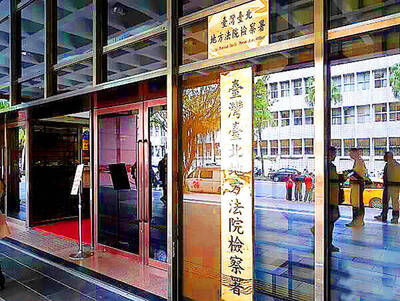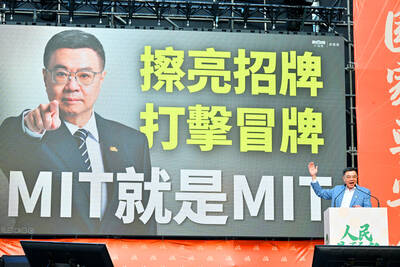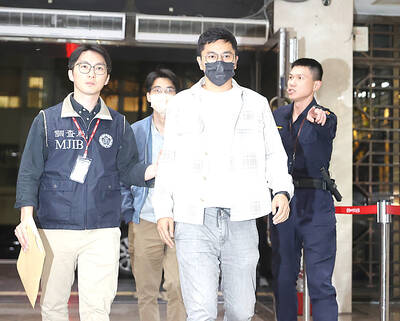To enhance its retaliatory strike capability, the military is now developing an air-launched anti-radiation missile capable of destroying air defense radar stations along China's southeastern coast.
According to the latest issue of Jane's Defense Weekly magazine, the anti-radiation missile has been test-launched once since it was developed, though the result of the test have not been publicized.
Defense sources told the Taipei Times that the test-launch was held somewhere off Hualien a few months ago and was launched from a Taiwan-made Indigenous Defense Fighter (
One of the main reasons behind the decision to use the IDF is that locally built weapons systems cannot be integrated with those of the F-16 for both technical and political reasons. The anti-radiation missile under development is based on the domestically-developed Sky Sword 2 (Tien Chien 2, or TC-2) air-to-air missile (AAM), which is itself a copycat of the US-made medium-range AIM 120 AAM. It is thus designated TC-2A.
Chang Li-teh (
"All we do know is that the TC-2A program is aimed at developing a capability to destroy China's air defense radar stations along its southeastern coast. The developer, the military-run Chungshan Institute of Science and Technology (CSIST), is now working hard on the terminal seeker portion of the missile," Chang said.
The terminal seeker is the device which guides a missile to its target and is the most sophisticated part of the weapon.
"The CSIST has actually produced a prototype seeker but it looks too large to fit the TC-2A missile. They must be trying to reduce the size of the seeker and upgrade its capabilities," he said.
"Technical problems involved in the development of the seeker are mainly about whether the seeker can overcome enemy electronic countermeasures. Put simply, if the enemy suddenly turns off the radar being targeted or releases decoys in the vicinity, will the seeker still be able to guide the missile to its destination?" he said.
According to classified information, the TC-2A missile, on which the anti-radiation missile is based, has a range of between 74km and 90km, enabling its carrier plane to fire at targets along China's southeastern coast from a safe distance in the Taiwan Strait.
The Strait, which separates Taiwan and China, is around 130km wide at its narrowest point and 250km at its widest.
The anti-radiation missile is expected to enhance considerably Taiwan's retaliatory strike capability against China, adding another option for the military to choose from in addition to the bombing of China's coastal facilities by the F-16s. It also fits into President Chen Shui-bian's (

INVESTIGATION: The case is the latest instance of a DPP figure being implicated in an espionage network accused of allegedly leaking information to Chinese intelligence Democratic Progressive Party (DPP) member Ho Jen-chieh (何仁傑) was detained and held incommunicado yesterday on suspicion of spying for China during his tenure as assistant to then-minister of foreign affairs Joseph Wu (吳釗燮). The Taipei District Prosecutors’ Office said Ho was implicated during its investigation into alleged spying activities by former Presidential Office consultant Wu Shang-yu (吳尚雨). Prosecutors said there is reason to believe Ho breached the National Security Act (國家安全法) by leaking classified Ministry of Foreign Affairs information to Chinese intelligence. Following interrogation, prosecutors petitioned the Taipei District Court to detain Ho, citing concerns over potential collusion or tampering of evidence. The

NEGOTIATIONS: The US response to the countermeasures and plans Taiwan presented has been positive, including boosting procurement and investment, the president said Taiwan is included in the first group for trade negotiations with the US, President William Lai (賴清德) said yesterday, as he seeks to shield Taiwanese exporters from a 32 percent tariff. In Washington, US Trade Representative Jamieson Greer said in an interview on Fox News on Thursday that he would speak to his Taiwanese and Israeli counterparts yesterday about tariffs after holding a long discussion with the Vietnamese earlier. US President Donald Trump on Wednesday postponed punishing levies on multiple trade partners, including Taiwan, for three months after trillions of US dollars were wiped off global markets. He has maintained a 10 percent

TRADE: The premier pledged safeguards on ‘Made in Taiwan’ labeling, anti-dumping measures and stricter export controls to strengthen its position in trade talks Products labeled “made in Taiwan” must be genuinely made in Taiwan, Premier Cho Jung-tai (卓榮泰) said yesterday, vowing to enforce strict safeguards against “origin laundering” and initiate anti-dumping investigations to prevent China dumping its products in Taiwan. Cho made the remarks in a discussion session with representatives from industries in Kaohsiung. In response to the US government’s recent announcement of “reciprocal” tariffs on its trading partners, President William Lai (賴清德) and Cho last week began a series of consultations with industry leaders nationwide to gather feedback and address concerns. Taiwanese and US officials held a videoconference on Friday evening to discuss the

PERSONAL DATA: The implicated KMT members allegedly compiled their petitions by copying names from party lists without the consent of the people concerned Judicial authorities searched six locations yesterday and questioned six people, including one elderly Chinese Nationalist Party (KMT) member and five KMT Youth League associates, about alleged signature forgery and fraud relating to their recall efforts against two Democratic Progressive Party (DPP) legislators. After launching a probe into alleged signature forgery and related fraud in the KMT’s recall effort, prosecutors received a number of complaints, including about one petition that had 1,748 signatures of voters whose family members said they had already passed away, and also voters who said they did not approve the use of their name, Taipei Deputy Chief Prosecutor